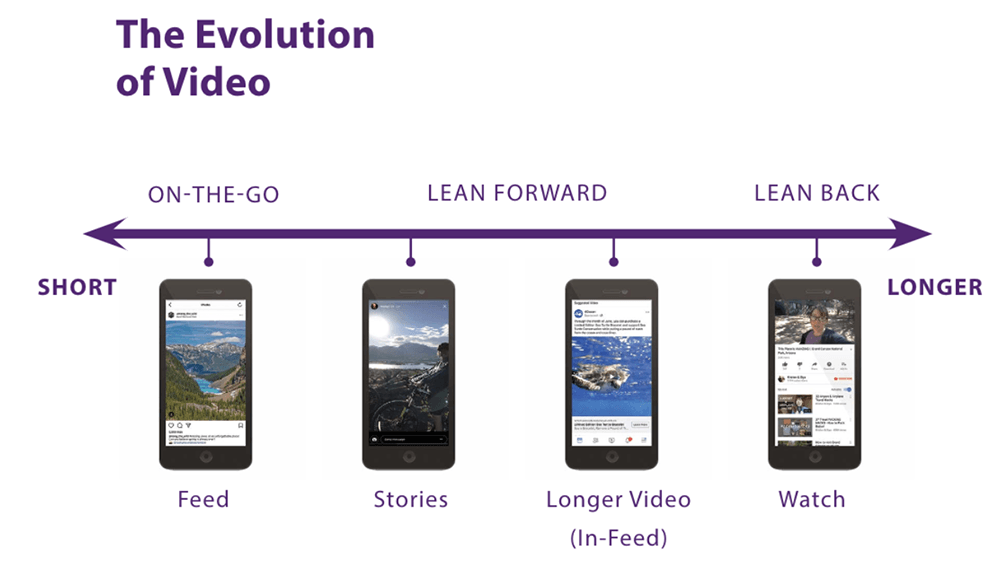Times have continued to rapidly change in the way video is consumed, and it’s important for marketers to stay up to date on new viewing trends in order to effectively reach customers wherever they are. In this case, I’m referring to Facebook video ads.
You have most likely noticed the increase in video content all over your Facebook News Feed. It seems marketers are leaning into this ad format because they’re recognizing that it’s what consumers want.
According to Facebook’s research, people’s eyes cannot resist new immersive and moving formats, with participants in their experiment gazing five times longer at video than static content. For obvious reasons, this is a huge opportunity that allows you to get in front of Facebook’s over two billion users. But while video has the potential to boost your organization to the top, there are a few things you need to keep in mind to get the most bang for your buck.
Here’s how to use Facebook video ads to drive the best results possible.
Step 1: Defining Your Audience
The first step in successfully running a Facebook campaign is understanding who you’re trying to reach and what you want them to do. Speaking Facebook’s lingo, this means determining your target audience and identifying the campaign objective.
For prospecting campaigns, I recommend testing multiple audiences. For example, maybe your core target audience is adults age 35-64 who are interested in outdoor activities, but you’re also interested in nurturing millennials. Between first-party and third-party data, you could have an interest-based audience and a lookalike audience for both your core audience demo & millennials, leaving you with four different audiences to test.
Step 2: Video Consumption & Channel Alignment
Once you’ve determined your audiences, it’s important to understand their video consumption habits so you can narrow in on what placements might work best. Our creative team often refers to Facebook’s three buckets for video consumption—“on-the-go, lean forward, and lean back.”
“On-the-go” Videos
If you think about your daily routine, this will most likely resonate with your own viewing habits. Most people are in the habit of watching short videos as they quickly skim their feeds throughout the day during any time they have while they’re on the go. According to Facebook, viewers consume content 41% faster on their mobile News Feeds than on their desktop News Feeds, which makes this “on-the-go” segment even harder to reach. It’s important to focus on capturing scrollers’ attention quickly, with only seconds available to get your message across.
“Lean Forward” Videos
Viewers seem to “lean forward” when they find a little more free time in the day, maybe while taking a break, and they have the time to watch stories or longer in-feed videos. With stories, you have a few more seconds to get your brand’s message across, but it still needs to get the job done in 15 seconds or less.
“Lean Back” Videos
Lastly, you might notice that you “lean back” and watch longer-form mobile videos, like a TED Talk, while lying in bed before going to sleep. Obviously as a viewer you have a very different mindset and attention span for ads depending on your intent at the time, which is why it’s so important for marketers to tailor the message depending on the placement.
Picking the Right Video Format
There are some key things marketers should keep in mind to ensure effectiveness of mobile video strategies.
First, always start with the audience. You need to determine the audience you’re trying to reach, and what channels will be most effective at getting in front of them. Is that channel “on-the-go,” “lean forward,” or “lean back,” or all of the above?
Second, think about optimizing video content for the audience and the channel. People treat their content consumption on each channel differently, so the creative content needs to be made for the attention they anticipate from that specific channel. Plus, we know people pay more attention to video on a smartphone (vs. a computer), so the creative needs to be mobile-optimized. Regardless of the placement, the focus should be on capturing viewers’ attention quickly and on highlighting the messaging and branding up front.
Lastly, try using videos that don’t require sound, or make sure to use captions so that viewers can engage freely wherever they may be.
Step 3: Make Certain That Channel Delivery Informs Creative Concept
There are many ways you can slice how video is consumed, and it will only continue evolving with advancements in technology. With video assets, it’s important to make sure you’re not only targeting the right audience in the right placement, but also that different types of video are created for the different goals across channels.
Aligning the creative and the paid media strategy is key, because the more relevant your ads are the more likely you are to succeed in the Facebook auction (which is necessary to see the results you want from paid media campaigns). It’s also important to keep in mind that content on mobile is consumed differently, so not all creative assets are created equal.
Step 4: Care About (and Track) the Right Metrics
Once you’ve successfully launched video ads, it’s time to experiment! The digital landscape allows you to test and iterate new ad formats and placements in order to develop the most effective ways video can be leveraged within your overall marketing strategy, so make sure to take advantage. You can still set up your campaign with a main objective of reach, conversions, or engagement, but with video there are other specific metrics that are important to understand. Here’s a list of Facebook’s video-related metrics that you should keep an eye on:
Facebook Video-Related Metric Glossary
- Reach: The number of people who saw your video ad.
- 2-second continuous video views: The number of times your video was played for 2 continuous seconds or more.
- Cost per 2-second continuous video view: The average cost for each 2-second continuous video view. This metric is calculated as total amount spent, divided by 2-second continuous video views.
- 3-second video views: The number of times your video played for at least 3 seconds, or for nearly its total length if it’s shorter than 3 seconds. For each impression of a video, we’ll count video views separately and exclude any time spent replaying the video.
- Cost per 3-second video view: The average cost for each 3-second video view. This metric is calculated as total amount spent, divided by 3-second video views.
- 10-second video views: The number of times your video played for at least 10 seconds, or for nearly its total length if it’s shorter than 10 seconds. For each impression of a video, we’ll count video views separately and exclude any time spent replaying the video.
- Cost per 10-second video view: The average cost per 10-second video view. This metric is calculated as total amount spent, divided by 10-second video views.
- Video plays: The number of times your video starts to play. This is counted for each impression of a video, and excludes replays.
- Video watches at 25%: The number of times your video was played at 25% of its length, including plays that skipped to this point.
- Video watches at 50%: The number of times your video was played at 50% of its length, including plays that skipped to this point.
- Video watches at 75%: The number of times your video was played at 75% of its length, including plays that skipped to this point.
- Video watches at 95%: The number of times your video was played at 95% of its length, including plays that skipped to this point.
- Video watches at 100%: The number of times your video was played at 100% of its length, including plays that skipped to this point.
- Video average watch time: The average time a video was played, including any time spent replaying the video for a single impression.
Facebook just recently announced that they’re changing the way 3-second and 10-second video view counts are calculated. Originally these view counts included any time spent rewinding & rewatching, so advertisers felt like they couldn’t accurately measure consumption. Now they’re updating these view metrics to only include unrepeated seconds of watch time. Facebook works to stay on top of evolving trends, like mobile video viewing, and does a good job of incorporating feedback from both marketers and consumers.
And Finally, Give It A Try!
The explosion in online video viewing is only going to continue. You only have a few seconds to get your brand’s message across, so make that time count! Video ads can tell an extremely engaging and meaningful story, so make sure it’s attention-grabbing and designed with the mobile screen in mind. It’s important to stay up-to-date on new ad placement trends, because they are only going to continue evolving. Get ahead of voice ads, mixed reality, augmented reality, and virtual reality, and master your video advertising strategy!
If you found this article helpful, check out 11 Facebook Ad Optimization Tactics Your Should Be Implementing for more tips and tricks.






